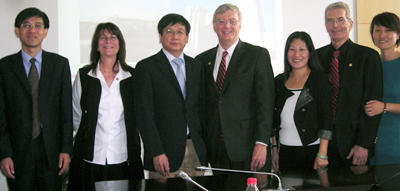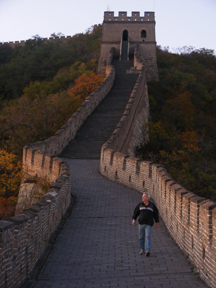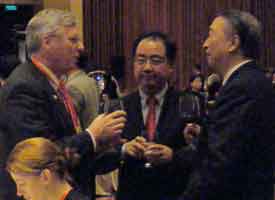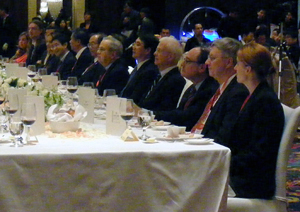Final Posting from Shanghai
The return to Shanghai by Bullet Train brought us to East China Normal University and Fudan University yesterday for a second round of conversations. East China Normal (ECNU) is a comprehensive university with many programmatic opportunities for teaching and research in the humanities, social sciences, economics, law, sciences, engineering, and teacher education. ECNU is ranked as the best Chinese institution for preparing teachers of Chinese as a foreign language. This, of course, is what strongly attracts us to ECNU: anchoring Chinese language study at Wabash is a high priority as we develop Asian Studies. But ECNU offers much more. The Shanghai campus is a beautiful setting, with two rivers running through the campus, home to 4,500 international students as well as 15,000 Chinese undergraduates and 14,000 graduate students. One also finds two national research laboratories and six research institutes, which regularly host liberal arts faculty from various US colleges and universities from around the world who come to attend the more than 20 international conferences held annually, or to collaborate with ECNU faculty. It is a vibrant and inviting place. The combination of student focus and high quality academic achievement makes ECNU, while very different in size, much like Wabash in spirit.
 Tuesday we celebrated the formal signing of a cooperative agreement with ECNU officials. Pat White and President Quan Chen inked documents – Pat White literally stamped the name of the College in Chinese characters onto the documents – that will lead to ECNU supplying elementary Chinese language instructors; welcoming Wabash students to pursue Chinese language study in immersion course, short summer, or semester-long programs; and supporting Wabash faculty who seek to expand their own Asian Studies research and teaching capabilities (for example, those faculty participating in the Mellon Grant program).
Tuesday we celebrated the formal signing of a cooperative agreement with ECNU officials. Pat White and President Quan Chen inked documents – Pat White literally stamped the name of the College in Chinese characters onto the documents – that will lead to ECNU supplying elementary Chinese language instructors; welcoming Wabash students to pursue Chinese language study in immersion course, short summer, or semester-long programs; and supporting Wabash faculty who seek to expand their own Asian Studies research and teaching capabilities (for example, those faculty participating in the Mellon Grant program).
ECNU representatives were intrigued by the Wabash all-male student learning environment and are eager to understand better our liberal arts curricular model. The strength of Chinese interest in all-male and liberal arts education was a surprising discovery for all of us. Along with many other Chinese institutions, ECNU is experimenting with general education or liberal arts type programs that focus on development of broad critical thinking and moral reasoning skills.
The data from the Wabash National Study of Liberal Arts Education got the attention of President Quan, a physicist by training, who indicated his staff needs to understand these data and best practices that strengthen student learning, especially on the part of men. Dean Huang Meixu, my counterpart, and I will pursue conversations about how best to facilitate a visit to the Center of Inquiry and to see how our own Teacher Education program works. Charlie Blaich believes the Center of Inquiry, too, can benefit from a better understanding of the Chinese educational transformation underway. This could be an exciting collaborative opportunity that promises to benefit everyone.
Mutual benefit results from shared respect and trust. Respect and trust emerge from relationships built and sustained. Because relationships are central to Chinese culture, there is no alternative to spending time in China in order to build and sustain them. Electronic engagements are instrumental; they can’t replace the face-to-face. To take China seriously you have to engage and that means you have to come to China.
What else have I learned? I realize more clearly than ever from this brief trip that Wabash indeed has much to learn from but also has much to offer to our Chinese colleagues: the Center of Inquiry in the Liberal Arts; our success in educating men to excel and be independent; the Gentleman’s Rule that elevates moral character and citizenship; and liberal arts teaching and learning practices that forefront academic excellence, deep human engagement, and diversity of experiences.
At Fudan, UIBE, and ECNU, we found Chinese educators wrestling with many of the same teaching and learning questions Wabash and other liberal arts institutions now face. The issues of internationalization and interdisciplinary education talked about at every stop turn out to be about more than infusing curriculum or co-curriculum with a certain academic content, although that is indeed important. They point to the fact that we share the same human questions about vocation, community, citizenship, education of the young, civic responsibility, and moral purpose. To have a global awareness is to comprehend not only how different we are in the specific ecologies of our home communities but also how profoundly alike in the questions we have about the wellbeing of our children, our environment, and our planet.
.jpg) The last six days in China have been a blur of travel, meetings, shared meals, short nights, and early-morning tackling of email and meeting preparations. It has been a time of connecting to potential new institutional colleagues; discovering teaching and learning opportunities for Wabash students and faculty; and, for me personally, finding a conversational partner in Fudan’s Dean Fan whose research in religion, violence, and culture overlaps with mine. She’s invited me to return to Fudan next June to lecture on Judaism and to study the famous Shanghai synagogue, home to thousands of European Jews who fled the Nazi killing machine. I very much want to return.
The last six days in China have been a blur of travel, meetings, shared meals, short nights, and early-morning tackling of email and meeting preparations. It has been a time of connecting to potential new institutional colleagues; discovering teaching and learning opportunities for Wabash students and faculty; and, for me personally, finding a conversational partner in Fudan’s Dean Fan whose research in religion, violence, and culture overlaps with mine. She’s invited me to return to Fudan next June to lecture on Judaism and to study the famous Shanghai synagogue, home to thousands of European Jews who fled the Nazi killing machine. I very much want to return.
As our visit draws to a close, I am acutely conscious that this has also been a time to reconnect with familiar colleagues. It is an index of our busy lives at home that you often have to go away to talk with those in the office next door, and to rediscover how good, competent, and caring your Wabash co-workers are. Alas, we take each other for granted this way.
Time spent with Qian, Kay, and Pat as representatives of the College, as close and now closer friends enriched by the bond of a common experience of travel, teaching, and learning in China, makes me appreciate all the more just how good it is to be in such company: in community with men and women devoted to making Wabash a better place to teach and learn.
This dedication was underscored all the more by the time spent with Wabash students: Hoa Liu, Victor Meng, and, just last night, Thomas Schmidt, who is presently studying Chinese at Fudan. Seeing all three Wabash men in China in action — confident, compassionate, and connected to the College and to one another and to us, representing Wabash. W-Nights half way around the world!
This is Wabash liberal arts education making a global difference in the lives of these young men and, yes, even some of us older folk. The really exciting news is that this is just the beginning.
Last Day in Bejing Yields Another Opportunity
It is Monday evening and we are speeding our way toward Shanghai from Beijing at 307 km/h on a Chinese Bullet Train. The CRH Bullet Train is a sleek vessel capable of achieving 400 km/h, but recent high profile mishaps have forced operators to restrain it to a more leisurely 190 miles/hr. A Jackie Chan movie plays on an overhead display as we race past a country side of patchwork family-size garden plots, cotton fields, donkey driven carts, and periodic clusters of high rise construction hovered over by gigantic construction cranes, China’s new “national bird” as Kay observes. The contrasts are jarring. But we are discovering that these antinomies are China. The rush forward into the modern age is matched equally by an inseparable anchoring to the past. The Great Wall, we are reminded, is a testament to a long tradition of Chinese construction. It is impossible not to feel the paradoxical continuity of ancient past and new future nearly everywhere we look.
Before leaving Beijing this afternoon we met with and were treated to lunch by the institutional leaders of the University of International Business and Economics. This 60-year-old institution was at one time the Beijing Institute of Foreign Trade. Restructured in 2000 as the China Institute of Banking and Finance, which was once attached to the Central Bank, UIBE is now a world-renowned business and economics school offering undergraduate and graduate degrees in business, law, statistics, economics, finance public, international relations, public administration, and, yes, even literature. UIBE also offers summer- and semester-long language programs to international students in 14 languages including Chinese, English, French, German, Italian, Portuguese, Russian, and Arabic and has begun experimenting with a general education program that requires undergraduates to take two years of liberal arts-type courses before launching into a major. This is not the norm in Chinese higher education where students typically choose a major before beginning their tertiary studies. Small in comparison to most other Chinese undergraduate and graduate programs in business and finance, UIBE has carved out a niche in producing a strong cohort of local, regional, and national economic leaders. This led Pat to see similarities with Wabash, a small liberal arts College that produces accomplished graduates out of proportion to its size.
Once again Hao Lui ’11 was very helpful in helping set up our meeting. We met with UIBE President, Professor Zhao Zhonxui; the Deputy Director of International Relations Xiang Jie; and the Director of the International Education Admissions Office Ms. Peiyuan Du and her Deputy Director Mr. Shao Jiani. Hao works closely with Mr. Shao in bringing his summer program in China. Over a working lunch – a redundancy in Chinese culture – we began the process of identifying common interests and purposes.
UIBE and Wabash will begin immediate discussions about crafting a working relationship between our two institutions. What we find attractive about UIBE are the opportunities for Wabash students to take short or long courses in language study and the full range of business and economics course. President Zhao has invited Wabash Economics Department faculty to come to Beijing to take advantage of UIBE’s programs and resources in the city, and Pat has invited President Zhao and his colleagues to visit Wabash and investigate the Center of Inquiry and our own liberal arts program. We see opportunities for students to learn first-hand about the Chinese economic experiment from those teachers and scholars most intimately connected to Chinese economic analysis and development. The immersion and internship possibilities are manifold.
Our time in Beijing has been exceptionally productive. We leave behind our alumnus Hao but come away with new relationships formed and great anticipation of China study opportunities for Wabash students and faculty alike. One of our proudest moments came in describing Hao to our hosts as the kind of Wabash man who takes hold of every opportunity to use his liberal arts education to the fullest extent possible to make a difference. We didn’t need to convince our hosts of Hao’s capabilities; they readily acknowledged this by the multi-year contract they have awarded him to help them expand their international student education and general education program.
Tuesday is our last full day in China. We will meet with representatives of East China Normal University and have further conversations with colleagues at Fudan. Like the Bullet Train, we have sped through these last days and see much accomplished in a short period of time. None of this would have been possible were it not for Qian Pullen’s extraordinarily capable guidance and instruction in the art of relationship building. My thanks especially to you, Qian. And while I’m at it thanks, Hao, for being a teacher to your teachers. Should we really be surprised?
October 16, 2011: Past and Present, China and Wabash
Great Wall of Li — After 72 hours of nonstop traveling, meetings, and working meals with newly made professional acquaintances at Fudan University and the China Educational Association for International Exchange, we shifted gears and traveled to the Great Wall. Situated some 90 minutes from downtown Beijing, the "Wan Li Chang Cheng" or "Great Wall of Li" is one of China's seven most-scenic and most-visited spots. We made the pilgrimage — with Hao Liu '11 graciously arranging the transportation and food — on a spectacular fall afternoon. We chose the late afternoon hoping to avoid the heavy sightseeing traffic and to visit the Great Wall under other than ordinary conditions. We were not disappointed.
Built over a period of 2000 years and completed in the early years of the Ming dynasty in the 15th century, the Great Wall served as a border and barrier to keep the outside world at bay and to safeguard Chinese life and culture from external pressures. The Wall only partially succeeded in doing its job. It is an awe-inspiring structure stretching 5,500 miles across mountain slopes and knife-edge peaks that one can hardly believe scalable much less buildable. I am told it is the only human-made object observable from space. It is a physically challenging experience walking the steep steps and uneven stones. Literally and figuratively it takes the breath away.
Although imposing, its very material presence reminds that the seemingly impossible is made possible when human ingenuity and effort are directed. And it also important to remember that the Wall was built by the conscripted labor of farmers, soldiers, and slaves who had a different experience of its beauty. Human projects are often mixed realities. I take the Great Wall as a metaphor for the College's effort to launch an Asian Studies initiative to enrich the lives of Wabash students: it is a substantial building project that requires lugging people and material great distances up and over mountains in the hope of creating something permanent. One important difference, however, is that our Asian Studies effort seeks not to separate Wabash students and faculty from Chinese people, culture, language, and history, but instead to connect them deeply.
 Kay, Qian, Pat, Hao, and I walked the top of the wall until the sunset. For the most part we were alone with the stone and the air and the sky and one another. For anyone familiar with Forster's A Passage to India, it had the feel of the Marabar Caves. We looked out over a vista of ragged mountaintops to see a fireball sun bring into relief sky and land, nature and culture, past and present, China and Wabash. It was a moment of antinomies brought together.
Kay, Qian, Pat, Hao, and I walked the top of the wall until the sunset. For the most part we were alone with the stone and the air and the sky and one another. For anyone familiar with Forster's A Passage to India, it had the feel of the Marabar Caves. We looked out over a vista of ragged mountaintops to see a fireball sun bring into relief sky and land, nature and culture, past and present, China and Wabash. It was a moment of antinomies brought together.
The irony of a Wall intended initially to separate now serving instead to bring together former student and teacher, East and West was impossible to miss. To see Hao and Kay, former student and teacher reunited now both engaged with Qian guiding our group down the thousand steps to our awaiting car in the failing light made me appreciate once again the power of liberal arts teaching: a student/teacher relationship now enriched by the presence of this new Chinese Wabash scholar who will help lead the next generation of Wabash men to the East. This is the new global reality of Wabash teaching and learning, and the excitement — and hard work — that awaits all of us if we are to make this venture succeed.
And there is more immediate hard work ahead. Monday we meet with the leadership of the University of International Business and Economics in Beijing about curricular and co-curricular opportunities for Wabash students. Then we take the high speed train back to Shanghai for a second round of meetings with Fudan University officials and representatives of East China Normal University on Tuesday. It will be a return to an intense schedule richly interrupted by an encounter with Wan Li Chang Cheng.
 The sessions, simultaneously translated in Chinese and English, were an intriguing mix of international voices wresting with the questions of international study quality assurance. With as many as 500,000 Chinese students expected to study away by 2020, the issue of assuring quality learning experience is high on the minds of Chinese educators and government officials. What we heard from Dr. Jiang and his world CEAIE partners was a familiar refrain echoed at the Center of Inquiry: what is the student learning experience? How do we know that international programs deliver the goods.? What are the mechanisms and measures to determine the quality of these programs? The student-centeredness of the effort resonated clearly as a Wabash concern; it was no surprise that we felt like we were in Trippet talking with Charlie Blaich and Teagle Scholars about how to use institutional data to strengthen the academic experience. We perceived much to be at stake in sending Chinese students abroad to uneven programs and the responsibility educators around the globe have toward assuring quality control over these programs.
The sessions, simultaneously translated in Chinese and English, were an intriguing mix of international voices wresting with the questions of international study quality assurance. With as many as 500,000 Chinese students expected to study away by 2020, the issue of assuring quality learning experience is high on the minds of Chinese educators and government officials. What we heard from Dr. Jiang and his world CEAIE partners was a familiar refrain echoed at the Center of Inquiry: what is the student learning experience? How do we know that international programs deliver the goods.? What are the mechanisms and measures to determine the quality of these programs? The student-centeredness of the effort resonated clearly as a Wabash concern; it was no surprise that we felt like we were in Trippet talking with Charlie Blaich and Teagle Scholars about how to use institutional data to strengthen the academic experience. We perceived much to be at stake in sending Chinese students abroad to uneven programs and the responsibility educators around the globe have toward assuring quality control over these programs..jpg) The day concluded with a banquet for several hundred guests and Pat sitting at the head table with Dr. Jiang and the CEAIE president Zhang Xinsheng. Victor Meng '09 and his fiancee joined us for dinner. Victor is working on summer school programming that brings American faculty together with Chinese students in Beijing and Shanghai. Dr. Jiang went out of his way to introduce many featured guests to Pat and the College to them. The evening ended with a stunning performance of Sichuan Opera Change Face dancers. It was spectacular and rare performance that few persons have the opportunity to witness let alone in this setting: only five performers in all of China, I am told, can perform this magical feat. The conference sessions and banquet were covered by Chinese national television. Don't be surprised if Pat White's face shows upon on the front page of tomorrow's The China Daily. Yes, this was a big deal.
The day concluded with a banquet for several hundred guests and Pat sitting at the head table with Dr. Jiang and the CEAIE president Zhang Xinsheng. Victor Meng '09 and his fiancee joined us for dinner. Victor is working on summer school programming that brings American faculty together with Chinese students in Beijing and Shanghai. Dr. Jiang went out of his way to introduce many featured guests to Pat and the College to them. The evening ended with a stunning performance of Sichuan Opera Change Face dancers. It was spectacular and rare performance that few persons have the opportunity to witness let alone in this setting: only five performers in all of China, I am told, can perform this magical feat. The conference sessions and banquet were covered by Chinese national television. Don't be surprised if Pat White's face shows upon on the front page of tomorrow's The China Daily. Yes, this was a big deal. It was a proud moment for me to see Pat at the head table. Think about it. Pat was representing Wabash, a tiny liberal arts college in the heart of the midwest, a partner at an international conference taking place half way around the world helping enact a part of China's next five year plan devoted to assessment and program quality assurance. Who would have thought. Relationships, aspiration to be the best, student centeredness, and commitment to international education as a means to enable Wabash students to become better world citizens, all this we share with Dr. Jiang, his Chinese associates, and his CEAIE colleagues. Never let it be said that a few people at a tiny place can't play a big role and make a difference for students, whether at home or abroad.
It was a proud moment for me to see Pat at the head table. Think about it. Pat was representing Wabash, a tiny liberal arts college in the heart of the midwest, a partner at an international conference taking place half way around the world helping enact a part of China's next five year plan devoted to assessment and program quality assurance. Who would have thought. Relationships, aspiration to be the best, student centeredness, and commitment to international education as a means to enable Wabash students to become better world citizens, all this we share with Dr. Jiang, his Chinese associates, and his CEAIE colleagues. Never let it be said that a few people at a tiny place can't play a big role and make a difference for students, whether at home or abroad.See the first day's post from Fudan University by clicking here.